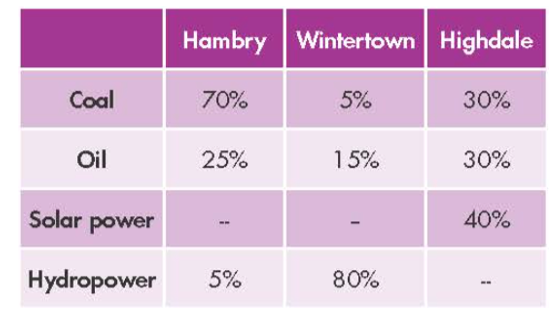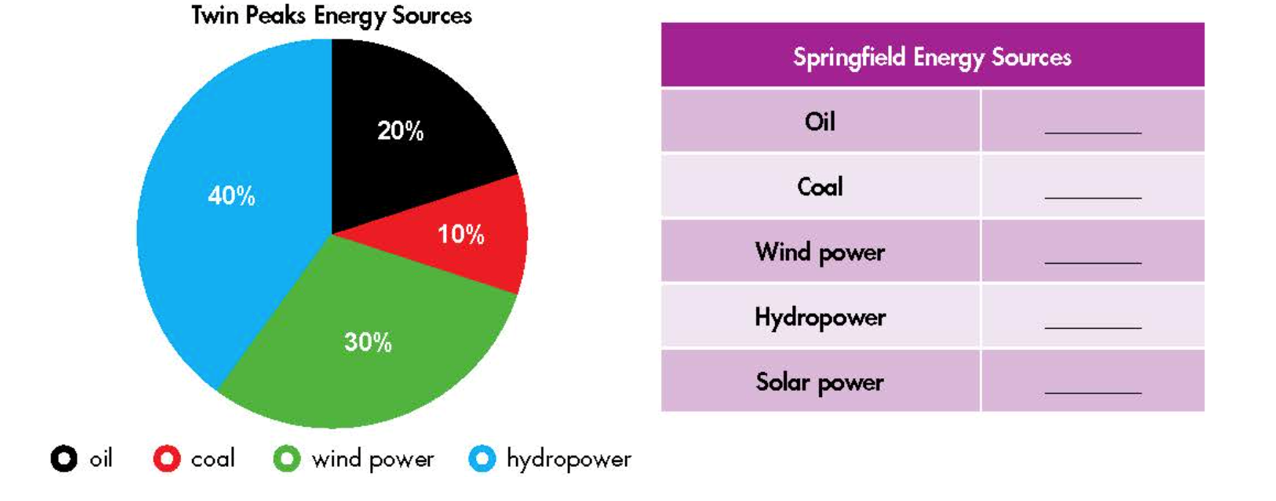Listen to Emma and James talking to experts at an energy convention. What do they want to learn about? (Nghe về Emma và James nói chuyện với chuyên gia ở một hội nghị năng lượng. Họ muốn học về điều gì?)

 Giải bởi Vietjack
Giải bởi Vietjack
Đáp án: 1
Nội dung bài nghe:
Michael: Yes. My name's Michael. How can I help you?
Emma: How much energy does Greenwood get from coal?
Michael: It gets sixteen percent from coal.
Emma: Did you say sixty or sixteen?
Michael: Sixteen percent.
Emma: How much energy does it get from renewable sources?
Michael: Fifty percent. We use lots of wind power.
Emma: OK. Thank you.
Michael: You're welcome.
James: Hi, are you Ann from Maple Falls Energy?
Ann: Yes.
James: Can I ask you some questions?
Ann: OK.
James: How much energy does Maple Falls get from coal?
Ann: Sixty percent.
James: How much energy does it get from wind power?
Ann: Just under three percent.
James: Thank you.
James: Hey Emma, Maple Falls gets less than three percent of its energy from renewable sources.
Emma: Greenwood gets fifty percent. It uses more renewable energy sources than Maple Falls.
James: So, Greenwood is greener than Maple Falls.
Hướng dẫn dịch:
Michael: Vâng. Tên tôi là Michael. Làm thế nào để tôi giúp bạn?
Emma: Greenwood lấy được bao nhiêu năng lượng từ than đá?
Michael: Nó lấy được 16% từ than đá.
Emma: Bạn nói sáu mươi hay mười sáu?
Michael: Mười sáu phần trăm.
Emma: Nó nhận được bao nhiêu năng lượng từ các nguồn tái tạo?
Michael: Năm mươi phần trăm. Chúng tôi sử dụng nhiều năng lượng gió.
Emma: Được rồi. Cảm ơn bạn.
Michael: Không có chi.
James: Xin chào, bạn có phải là Ann đến từ Maple Falls Energy không?
Ann: Vâng.
James: Tôi có thể hỏi bạn một số câu hỏi?
Ann: Được rồi.
James: Maple Falls nhận được bao nhiêu năng lượng từ than đá?
Ann: Sáu mươi phần trăm.
James: Nó thu được bao nhiêu năng lượng từ năng lượng gió?
Ann: Chỉ dưới ba phần trăm.
James: Cảm ơn bạn.
James: Này Emma, Maple Falls nhận được ít hơn ba phần trăm năng lượng từ các nguồn tái tạo.
Emma: Greenwood được 50 phần trăm. Nó sử dụng nhiều nguồn năng lượng tái tạo hơn Maple Falls.
James: Vì vậy, Greenwood xanh hơn Maple Falls.
Gói VIP thi online tại VietJack (chỉ 400k/1 năm học), luyện tập gần 1 triệu câu hỏi có đáp án chi tiết
3. than/ gets/ Springfield/ from/ energy/ 40%/ less/ Twin Peaks./ solar/ power
Unscramble the sentences. (Sắp xếp câu.)
1. electricity/ than/ 20%/ more/ Towns/ use/ villages.
4. in/ use/ Springfield/ electricity/ in/ Twin Peaks./ People/ than/ people/ more
Ask and answer. Then, compare energy sources in Bigton and Greenville. Swap roles and repeat. (Hỏi và trả lời. Sau đó, so sánh các nguồn năng lượng ở Bigton và Greenville. Đổi vai và lặp lại.)
Look at the table and write the sentences. (Nhìn bảng và viết câu.)

Stress the first syllable for numbers which are multiples of ten. (Nhấn mạnh âm tiết đầu tiên cho các số tròn chục.)
Compare the energy sources for Twin Peaks and Springfield. Which city uses more renewable energy? (So sánh nguồn năng lượng giữa Twin Peaks và Springfield. Thành phố nào sử dụng nhiều năng lượng tái tạo hơn?)
In pairs: Discuss which renewable energy source could be useful where you live. (Theo cặp: Thảo luận những năng lượng tái tạo có thể giúp ích cho nơi bạn sinh sống.)
In pairs: What sources of energy does your country use? Do you think it uses more non-renewable or renewable energy? (Theo cặp: Nguồn năng lượng nào đất nước bạn sử dụng? Bạn nghĩ nó sử dụng nhiều năng lượng không tái tạo hay năng lượng tái tạo?)
You're an energy expert interested in how two different cities use different kinds of energy. In pairs: Student B, it p.123 File 11. Student A, ask about Springfield and complete the table. Swap roles. Answer questions about Twin Peaks. (Bạn là một chuyên gia quan tâm về việc hai thành phố khác nhau sử dụng những loại năng lượng khác nhau như thế nào. Theo cặp: Học sinh B, file 11 trang 123. Học sinh A, hỏi về Springfield và hoàn thành bảng. Hoán đổi vai trò. Trả lời câu hỏi về Twin Peaks.)

In pairs: Compare more information from the table. Use the prompts. (Theo cặp: So sánh thông tin từ bảng và sử dụng gợi ý.)
Listen and cross out the word that doesn't follow the note in "a." (Nghe và loại bỏ từ không tuân theo ghi chú phần a.)

Listen to the words and focus on the underlined letters. (Nghe các từ và chú ý chữ cái được gạch chân.)
